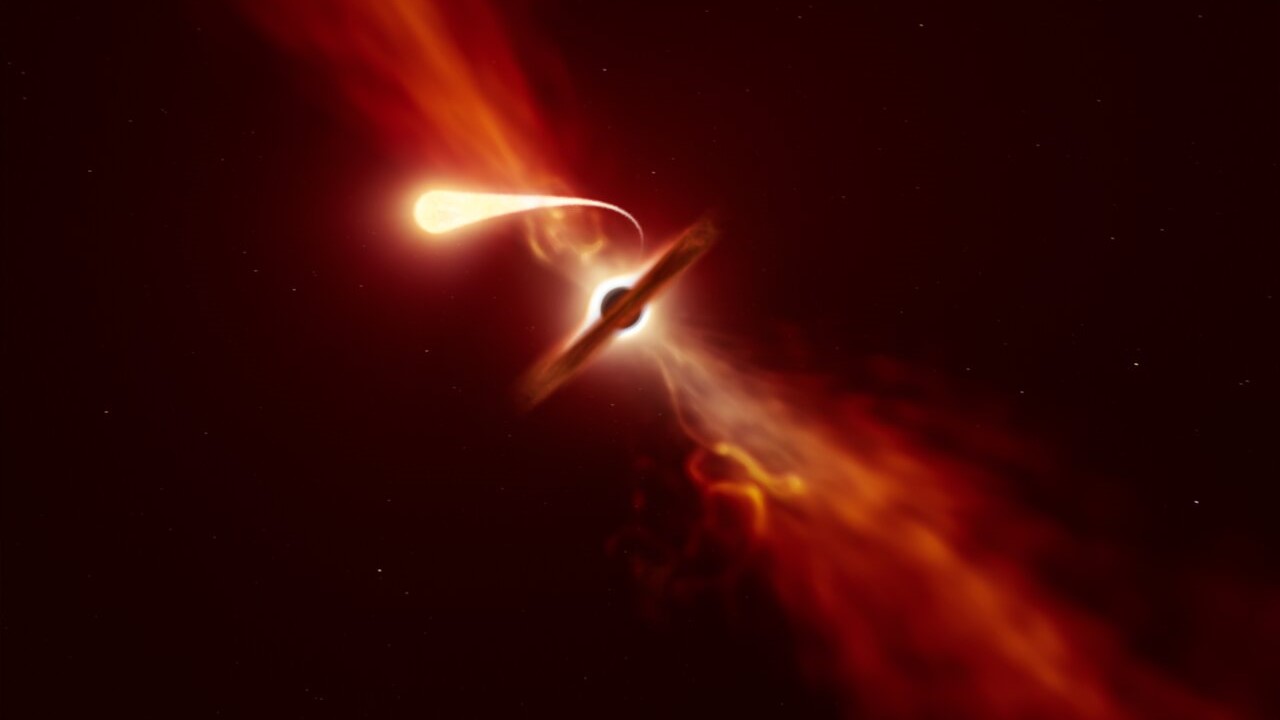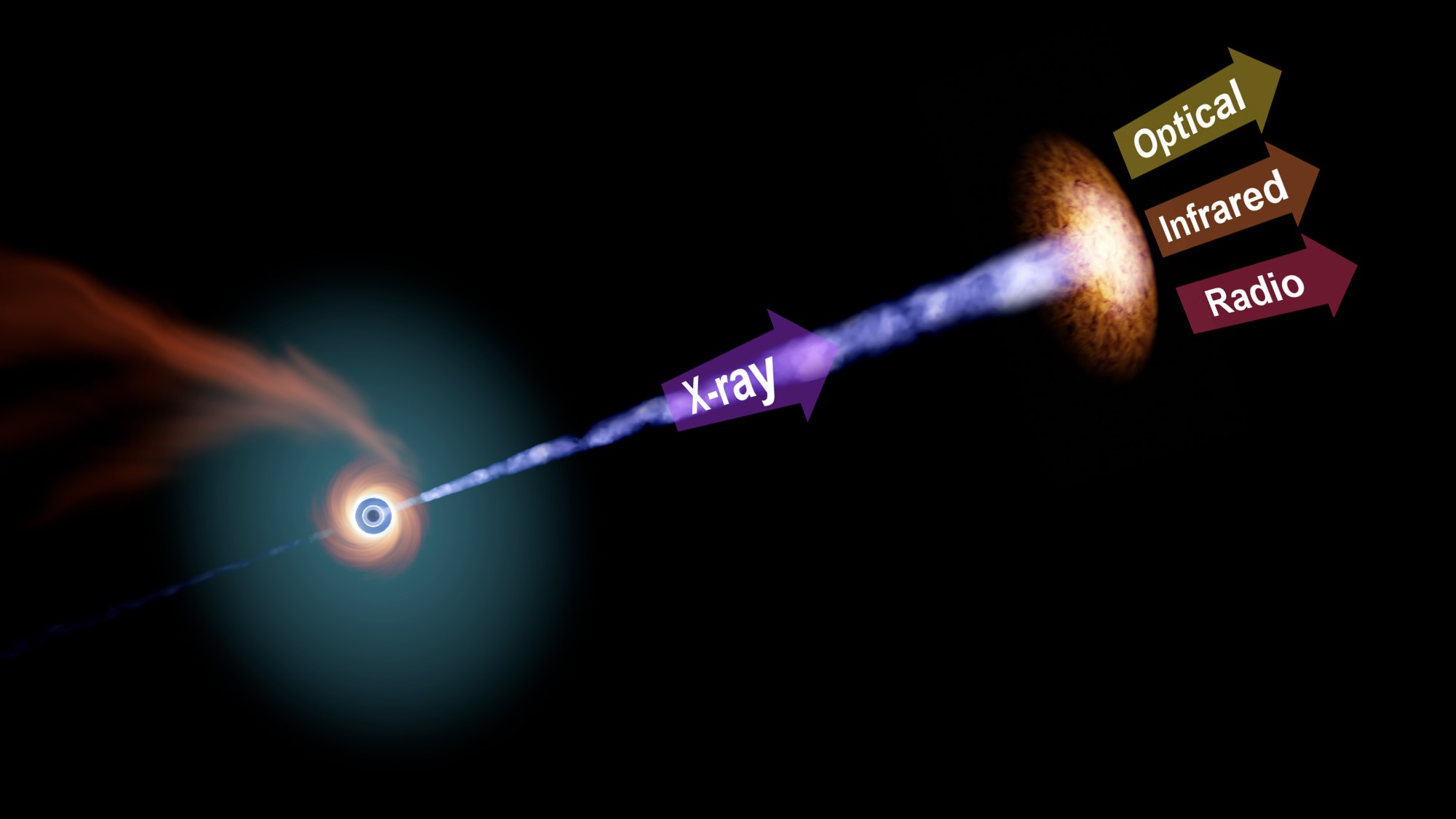Astronomers witness 18 ravenous black holes ripping up and devouring stars
The gruesome discoveries more than double the number of tidal disruption events found in the local universe.

It's a cosmic jungle out there for stars that venture too close to black holes. A team from the Massachusetts Institute of Technology has found 18 new examples of black holes that are ripping apart stars and feasting upon their remains.
This result more than doubles the number of gruesome, star-shredding Tidal Disruption Events (TDEs) seen in the local universe. The findings could help astronomers better estimate the number of TDEs occurring across the universe, bringing the rate closer to theoretical predictions.
TDEs occur when a star gets too close to a black hole, and the latter object's gravitational influence generates tidal forces in the star so great that the stellar body is stretched vertically while squashed horizontally, a process called "spaghettification."
The material from the star forms a flattened disk around the black hole, with some of it accreting to the black hole's heart, while other stellar matter is channeled to the poles by powerful magnetic fields and blasted out as near-light speed jets.
Related: Black hole shreds star in a cosmic feeding frenzy that has astronomers thrilled
Previously, astronomers had believed that black holes rip apart and devour stars while blasting out highly energetic jets in galaxies that have recently undergone periods of intense star birth called "starbursts."
This research, however, implies TDEs can occur across a wider range of galaxies and could help explain the extreme physics seen around such events.
Breaking space news, the latest updates on rocket launches, skywatching events and more!
"People were coming up with very exotic solutions to these puzzles, and now we’ve come to the point where we can resolve all of them," Erin Kara, team member and an assistant professor of physics at MIT, said in a statement.
How the Tidal Disruption Event hunt began
The MIT team began searching for more star-devouring black holes after they discovered the closest TDE to Earth ever seen. It was witnessed in the form of a flare from the galaxy NGC 7392, located around 137 million light-years from Earth.
This opened up an entirely new way to spot actively feeding black holes, they said. It involves using infrared light and an algorithm that hunts for patterns in infrared data that indicate brief or "transient" bursts of radiation. The technique completed was based on historical data collected by NASA's Wide-field Infrared Survey Explorer (NEOWISE). Since its launch in 2009, NEOWISE has been searching the sky over Earth for brief bursts of infrared light.
The team then cross-referenced the transients they found with a catalog of galaxies within a distance of 600 million light-years of Earth, revealing that the infrared bursts could be traced back to about 1,000 galaxies.
Zooming in on these galaxies, the researchers attempted to discover if the signals they had detected came from TDEs or if they could have been triggered by other violent events, such as the supernova explosion of a massive dying star. It'd also have been possible for them to come from supermassive black holes at the hearts of galaxies as they feed on in falling dust and gas.
This ultimately led to the discovery of 18 legitimate TDE signals that were the result of the gravitational influence of black holes generating tidal forces in stars that eventually led to some gory stellar deaths.
Surprisingly, the team found that TDEs seem to occur across a range of galaxies across the entire sky, including ones that are filled with thick clouds of dust.
"If you looked up in the sky and saw a bunch of galaxies, the TDEs would occur representatively in all of them," research lead author and MIT's Kavli Institute for Astrophysics and Space Research graduate student Megan Masterson said.
Hiding cosmic crimes
In the grand scheme of things, this research helps settle some major questions surrounding tidal disruption events.
Previously, astronomers had mainly seen these star-shredding occurrences happening in post-starburst galaxies with stellar factories that'd recently shut down.
Such galaxies are fairly rare, and scientists were confused as to why TDEs seemed restricted to them. This research alleviates that confusion by finding gory TDEs in a spread of galaxy types.
The reason TDEs were seemingly absent from other galaxies is that, whereas post-starburst galaxies are devoid of thick gas and dust because they exhausted the materials while creating a wealth of new stars, other galaxies still have the material in abundance. Gas and dust are adept at absorbing or blocking optical and X-ray light, but infrared slips through the matter more easily.
Thus, X-ray and optical emissions were fine for spotting TDEs in dust-depleted galaxies, but infrared observations were key in finding star-shredding black holes in dusty galaxies.
"It's not that they’re only occurring in one type of galaxy, as people thought based only on optical and X-ray searches," Masterson added. "If you want to understand TDEs as a whole and use them to probe supermassive black hole demographics, you need to look in the infrared band."
The findings from the MIT researchers could also explain why TDEs don't seem to radiate as much energy as is predicted by theory, with the team suggesting that the energy deficit is the result of dust absorbing optical and X-ray emissions, as well as extreme ultraviolet radiation from TDEs.
Adding the 18 new TDEs they discovered to previously observed events of this nature, the MIT team estimates that galaxies experience a TDE roughly once every 50,000 years, which is in line with previous theoretical predictions.
"This gives us confidence that we don't need all this exotic physics to explain what we’re seeing," Kara concluded. "And we have a better handle on the mechanics behind how a star gets ripped apart and gobbled up by a black hole. We’re understanding these systems better.”
The team's research was published on Monday (Jan. 29) in the Astrophysical Journal..

Robert Lea is a science journalist in the U.K. whose articles have been published in Physics World, New Scientist, Astronomy Magazine, All About Space, Newsweek and ZME Science. He also writes about science communication for Elsevier and the European Journal of Physics. Rob holds a bachelor of science degree in physics and astronomy from the U.K.’s Open University. Follow him on Twitter @sciencef1rst.

